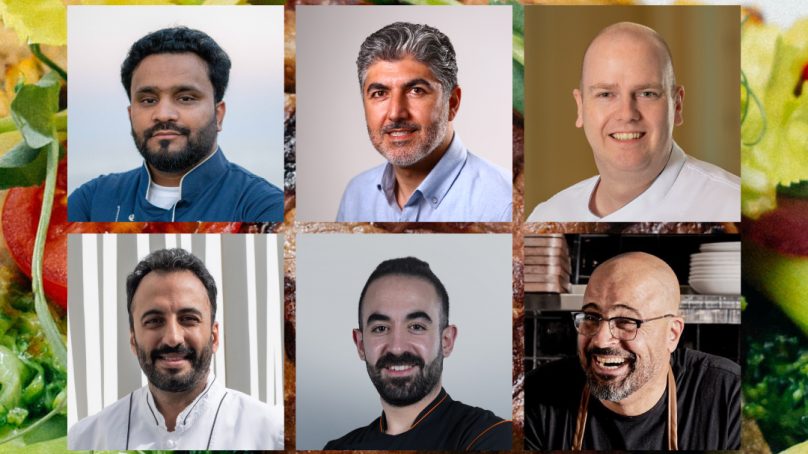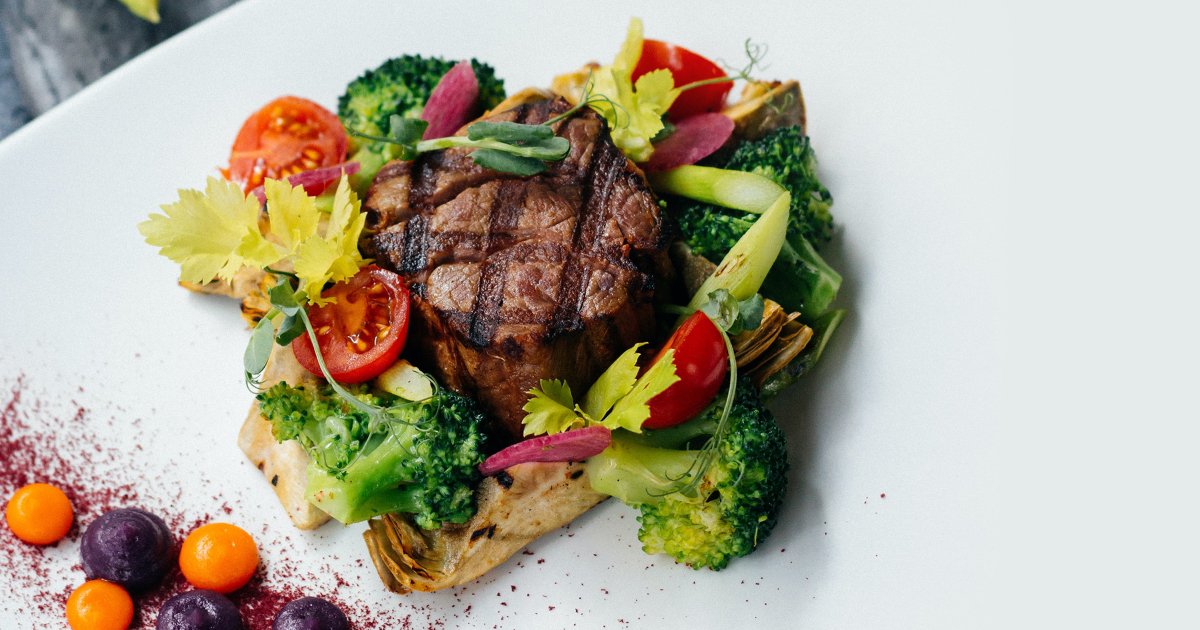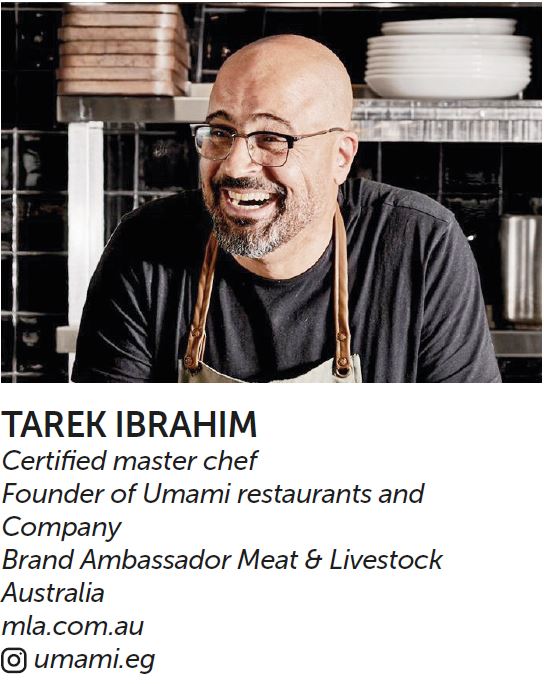We sat down with six meat-specialist chefs to get our teeth into the latest trends, what customers are ordering, marble scoring and the grass-fed versus grain-fed debate.



Authentic flavors
Meat lovers around the world are keen to see new and unique techniques to experience different cuisines. I am noticing that the asado (South American) style of cooking is becoming very popular in the Middle East. South American cooking is authentic and often involves a grill, called a parrilla, or an open fire. They have great cuts of meat and awesome flavors.
Prime rib
It’s a tough choice between prime rib and ribeye; but I would go with prime rib, as the percentage of marbling means that I can cook it in different ways. Prime ribs and ribeye steaks come from the same primal cut of beef – the difference in their flavors comes from the way they are cooked. Prime rib is seared and then roasted at low heat, making it more tender, while ribeye is flash grilled at high heat for a charred effect.
Variety speaks volumes
Diversity in a menu is key for attracting a range of audiences. As everyone knows, the percentage of vegetarians and vegans is very low compared to those who consume meat. Indeed, out of 10 customers, there will only be one who doesn’t eat meat. Having variety on a menu allows chefs to showcase their skills and create innovative dishes. In fact, the world’s most renowned chefs like to experiment with meat, which is why they often introduce a range of cuts to suit different tastes.
Keep it natural
I believe that each cut of meat requires a specific technique. It needs to be trimmed in the right way, stored at the right temperature, marinated (if necessary) and left to rest before serving. It’s important to avoid using any kind of meat tenderization powders or over-seasoning the meat.
Australian beef
There are many premium brands out there, but I tend to stick to True Aussie Beef and Lamb for three main reasons: tenderness, juiciness and flavor.

Marbling matters
I believe that it’s possible to create your own trend, whether it’s with meat or another type of food. For example, in addition to offering a selection of premium cuts like ribeye, fillet and tomahawk at Hunter & Barrel Restaurant in the UAE, I also included a flank BMS 9+. It is normally considered a secondary cut of meat; however, with a high marble score of 9+ and a special coating of charcoal powder and herb crust, this dish was elevated to gourmet standard and became one of our top sellers. This shows you that with a bit of creativity, expertise, market knowledge and forward thinking, one can set new trends in the culinary field.
First choice
My favorite meat cut is the picanha steak, also known as rump cap, sirloin cap or culotte steak. The picanha is a Brazilian cut of meat taken from the top of the rump cap muscle. It is not as well known as other cuts, but it has a distinctive flavor.
It is triangular in shape and has a thick layer of fat over the top. In addition, due to where it is located on a cow’s body, it is not an overused muscle, which means that the meat has naturally more marbling and fat. These are all key factors that contribute to the tenderness and flavor of this meat cut.
Furthermore, it is simple to cook: usually only seasoned with a generous amount of coarse salt and grilled to medium rare, fat side first. These fatty juices, when infused with the steak during the cooking process, give the meat a bold beefy flavor.
The meat pairs well with a chimichurri sauce and any kind of accompaniment, such as a crispy salad or grilled vegetables.
It’s all about protein!
It is important to note that meat is one of the main sources of dietary protein. In addition, most diners want variety and expect to see meat on the menu. Furthermore, meat — especially beef — is very versatile and allows us chefs to be creative and innovative while using a variety of cuts, seasoning blends, sauces and sides to please our customers and keep them coming back.
Finally, beef is good for business because it raises average checks, as diners who order beef dishes seem to spend more on items such as alcohol, appetizers and side dishes.
Top tips
Firstly, preheat the grill before you start cooking and ensure it reaches a high temperature. Preheating ensures steaks are cooked evenly and consistently, prevents overcooking, creates sear marks that add a smoky grilled flavor to the meat and even helps degrease the grates, making it easier to flip the steak and remove food residue.
Secondly, brush the steak with clarified butter during the grilling process to add flavor and moisture. One of the advantages of clarified butter is that it has a higher smoke point than regular butter. Therefore, it combines well with the steak while cooking.
Thirdly, a grilled steak needs to rest for around three or four minutes before you serve it. This resting period allows the juices to be reabsorbed and redistributed evenly through the meat, resulting in a more tender and juicy piece of steak. However, by cutting it too soon after cooking, the juices will flow away, leaving you with an overcooked piece of meat.
Wagyu all the way
Regardless of the brand of meat you select, it is important to apply the proper grilling techniques for a good result. In my opinion, this is one of the key elements to consider, as it has a direct impact on the quality of the cooked meat, affecting its tenderness, flavor and juiciness.
My preferred brand of meat is the Mayura full blood wagyu beef, chocolate-fed. The meat produced at the Mayura Station has an exquisite taste. The cattle’s grain diet is supplemented with sweet treats, namely Cadbury’s chocolate and biscuits! This gives the beef its unique sweet flavor, with a nutty undertone and buttery texture.

Trends
Consumers want to know the origin of the meat. With instant access to information, if consumers cannot understand or find out where and how a meat product is made and what is in it, they will be more inclined to steer in the direction of alternative products made by companies that have a genuine commitment to sustainability and improving the environment.
New York strip
The porterhouse, a T-bone steak, is all about indulgence. It combines the tenderness of a filet mignon with the meaty New York strip, so you don’t have to choose one steak over another. It’s so large that it can be shared. Cook it quickly on a high heat to begin with then move to a cooler place to rest before enjoying.
Menu staple
Meat is not just high in protein; it is also a source of many nutrients that are simply not available in plants. In my opinion, it is a staple on a restaurant menu.
Take my advice
There are so many ways to cook meat. Choose a lean cut of meat, like a lean rump steak, to begin with. Grill your meat and don’t add extra oil when you are cooking.
Use a low-fat marinade to give your meat a great flavor. Marinades also tenderize your meat and keep it moist during the cooking process. If you are roasting meat, place the cut on a metal rack above the roasting pan so the fat drips from it.
Big in Japan
In my opinion, Japanese cattle have the most marbling, providing a wonderfully juicy and extremely tasty dining experience. A high level of marbling makes these cuts great for grilling and other dry-cooking methods.

Consumer taste
Consumers are engaging with their favorite restaurants in different ways. They expect convenience at every step: from entering to ordering. In my opinion, being a highly personalized chef is the key for success, which is why we created a new restaurant in Jeddah called Cyan. Guests can watch their food being prepared every step of the way. This level of transparency is putting our customers at ease and allowing them to be part of the whole experience.
Bestsellers
The Wagyu beef tenderloin and Angus beef burger are our bestsellers due to the high quality of meat we use. Our Wagyu is Tajima, which is known for its refined marbling. In addition to our beef tenderloin, our short ribs are popular. The dish comprises braised beef ribs served with chipotle mayo. The croquettes are simply delicious.
Also, our rack of lamb and lamb shanks sell very well. When it comes to Saudi Arabia, we have a different perspective. There, they love to cook the whole baby lamb roast in the oven or use the traditional underground cooking technique.
Educating customers
Meat awareness is our responsibility as restaurateurs and chefs. There is a significant difference in meat knowledge between countries. As a chef, I insist on providing guests with plenty of information regarding the dishes served to them, such as the origin, breed, aging and so forth. We even train our staff to deliver the highest level of service and interact confidently with our clients.

What’s trendy?
Talking about trends, grass-fed beef has been a hot topic for some time now. No wonder it has crept into steakhouses, as it has significantly lower levels of saturated fat compared to grain-fed beef. We must not forget that massive cuts, like tomahawk, naturally draw in crowds. Indeed, when it comes to steaks, it seems to be the bigger the better. A large number of people who dine out post their dishes on their social media pages.
Preferred cut
When it comes to my favorite cut I always go for the bone-in New York strip steak; it’s hard to beat, in my opinion. Although it is not the most tender steak, it is packed with flavor. One of the reasons people love it is for its great bite and solid chew. When you’re shopping for New York strips, look for pieces that have even marbling throughout and larger chunks of fat around the edges.
Meat on the menu
Meat is an important element in most diets. It satisfies a person’s energy and nutritious needs, as the meat contains protein, fat and water that can be easily stored and consumed throughout the year.
In addition to it being rich in iron, vitamins and other minerals, its biological value is superior to that of most vegetables. In fact, humans require around two grams of protein per day, which can be obtained from meat alone.
Cooking techniques
There are a few basic rules for cooking meat. Every cut is different, so make sure you use the right piece of the animal for the correct method of preparation. Steak, specially the tender cuts like filet mignon, ribeye and New York strip, don’t need much when it comes to cooking, as you’re either grilling or pan-searing. It’s essential to make sure you apply high heat to create a delicious texture and flavor that will maintain a natural crust on the meat’s exterior. Rest your meat for at least the same amount of time that you cooked it. For tougher cuts, like brisket and short ribs, cook at a lower temperature for a couple of hours either by roasting, brazing or by using the sous-vide method.
Marble magic
Wagyu is considered the best beef on the planet because it is highly marbled. Marbling refers to the visible layers of intramuscular fat. It’s the type of meat that I wouldn’t mind traveling the world to enjoy, although that’s not necessary these days as everything can be ordered online and delivered straight to your door.

Simplicity is key
Simple food made well is what’s trendy. Most of the food we serve has been prepared lovingly and doesn’t exceed five or six ingredients, including salt and pepper, so it is very important to focus on the craft of making the food and high-quality ingredients. Simplicity is key: going back to the old dishes that people were used to seeing and reimagining them without the fuss.
I use natural stocks and glazes made from bones or chicken broth from old and aging chicken, for example. This gives me a very clear stock that I can use to create the deep flavor that I want. People always say how much they like the dish. For example, we do something called porretta chicken. The ingredients in it are very simple, namely soya sauce, a knob of butter, a little onion, some basil and cream sautéed chicken. There are very few ingredients, but people absolutely love it! That is what I want to introduce, not only in Egypt but also in the Middle East in general. I make everything from scratch, although I use foreign ingredients; I would like to emphasize that I do it with “Egyptian hands,” which I am very proud of. When it comes to burgers, I use wagyu beef in my restaurants. It’s a favorite among guests.
Bestselling items
Tenderloin is the most popular cut because people consider it to be tender and nice. I personally disagree, but it still remains the most popular cut, even in my restaurants.
Lamb
Rack of lamb is one of the most popular cuts of lamb. It is small, easy to eat and very tasty. Even though most people in Egypt and Lebanon are not consumers of it, except on special holidays, we still have considerable demand for rack of lamb at the restaurant.
Beyond grass-fed meat
A problem I sometimes face is clients wanting to remove certain items from a dish. I encourage them to keep the items as they are, without touching any ingredients/items, as this avoids altering the essence of the dish. In my view, people need further education, and they need to let the chef do their job because once you amend a plate, you change its whole identity.
Each nation in the Middle East still prefers to consume local meat. There is a gap in this area. Those who understand meat will consume Australian or U.S. meat. The trend nowadays is to consume grass-fed meat as it is considered to be more natural. Still, a large number of people are not educated enough when it comes to meat; they are unable to distinguish between the meats’ provenance, or grass-fed beef versus grain-fed beef.
















